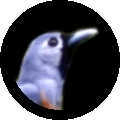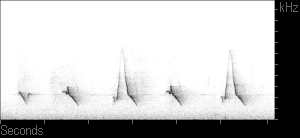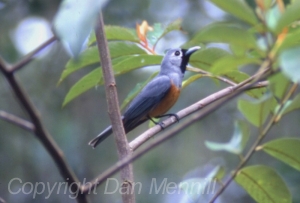 Black-faced Monarch
Black-faced Monarch
Monarcha melanopsis
 Figure 1. Spectrogram of the
Black-faced Monarch song.
Figure 1. Spectrogram of the
Black-faced Monarch song. (The third song in the sound file is depicted.)

Black-faced Monarch - Monarcha melanopsis
The black-faced monarch’s song is composed of a series of clear, evenly-spaced whistled notes. All songs that I recorded included exactly three types of syllables; a short and quiet introductory syllable, a louder downslurred syllable, and an emphatic up-and-down terminal syllable. Pizzey and Knight suggest these syllables sound like ‘why-you which-you’, however they point out that black-faced monarchs also sing a variety of other whistled patterns. The first two songs in the above sound file are three-syllable songs, whereas the third and fourth songs contain repeats of the last two syllables, as shown in figure 1.
I first encountered a black-faced monarch singing from a dense thicket in the Atherton rainforest. This male sang from a low, hidden perch and I could not see him as I recorded his songs. To bring him into view, I played a short recording of his songs back to him. The black-faced monarch responded to this playback immediately and aggressively, jumping out from his hidden song perch and passing back and forth overtop of my playback speaker and singing at a very high rate. Although most of his songs prior to playback had been three-syllable songs, most of his songs following playback were five-syllable songs, suggesting that black-faced monarchs may repeat syllables as an aggressive behaviour.
Black-faced monarchs also give a harsh, yapping call note, given either singly or in pairs. The end of the sound file includes several call notes given by the same male after he ceased his aggressive response to playback.
Habitat.
Black-faced monarchs live in wet sections of rainforest and eucalypt forest during the breeding season, but may be seen in more open habitat during the non-breeding season.
Range.
Black-faced monarchs are found throughout the entire eastern coast of Australia from Cape York to Melbourn. Many migrate to Papua New Guinea in the non-breeding season.
Further Reading.
G. Pizzey & F. Knight. 1999.
Field
guide to the birds of Australia. Harper Collins, Sydney.
No recordings, photographs, or other information may be used without written permission (email me at dmennill AT uwindsor DOT ca).